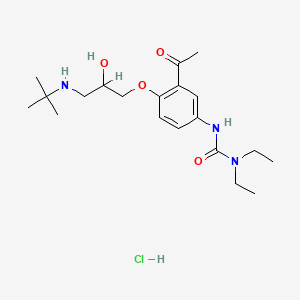



1. Celiprolol
2. Celiprolol Monohydrochloride
3. Celiprolol, (+,-)-isomer
4. Celiprolol, (r)-isomer
5. Celiprolol, (s)-isomer
6. Celiprolol, Monohydrochloride, (r)-isomer
7. Celiprolol, Monohydrochloride, (s)-isomer
8. Hydrochloride, Celiprolol
9. Monohydrochloride, Celiprolol
10. N'-(3-acetyl-4-(3-((1,1-dimethylethyl)amino)-2-hydroxypropoxy)phenyl)-n,n-diethylurea
11. Rev 5320a
12. Rev-5320a
13. Rev5320a
14. Selectol
15. St 1396
16. St-1396
17. St1396
1. 57470-78-7
2. Celiprolol Hcl
3. Selectol
4. Celiprolol (hydrochloride)
5. Celiprolol Hydrochloride [usan]
6. Celectol
7. Nsc-324509
8. 3-(3-acetyl-4-(3-(tert-butylamino)-2-hydroxypropoxy)phenyl)-1,1-diethylurea Hydrochloride
9. 3-[3-acetyl-4-[3-(tert-butylamino)-2-hydroxypropoxy]phenyl]-1,1-diethylurea;hydrochloride
10. Selectrol
11. G1m3398594
12. Dsstox_cid_26850
13. Dsstox_rid_81959
14. Dsstox_gsid_46850
15. Selecor
16. St 1396
17. Selectol (tn)
18. Cas-57470-78-7
19. Ccris 1095
20. Celiprolol Clorhidrato
21. Celiprololhydrochloride
22. Celiprolol Clorhidrato [spanish]
23. Celiprolol Hydrochlorid
24. Celiprolol Hydrochlorid [german]
25. St-1396
26. Clorhidrato De Celiprolol
27. Clorhidrato De Celiprolol [spanish]
28. Einecs 260-752-2
29. Cordiax
30. Unii-g1m3398594
31. Nsc 324509
32. Celipolol Hydrochloride
33. Ncgc00181108-01
34. 3-(3-acetil-4-(3-tert-butilamino-2-hidroxipropoxi)fenil)-1,1-dietilurea Hcl [spanish]
35. 3-(3-acetyl-4-(3-(tert-butylamino)-2-hydroxypropoxy)phenyl)-1,1-diethylurea Monohydrochloride
36. 3-(3-acetyl-4-(3-tert-butylamino-2-hydroxypropoxy)phenyl)-1,1-diethylharnstoff Hcl [german]
37. 3-(3-acetyl-4-(3-tert-butylamino-2-hydroxypropoxy)phenyl)-1,1-diethylurea Hydrochloride
38. Celipolol Hydrochloride,(s)
39. Acer002
40. Schembl349227
41. Acer-002
42. Chembl1742424
43. Dtxsid0046850
44. Chebi:31385
45. Bcp13692
46. Hy-b1264
47. Tox21_112722
48. Celiprolol Hydrochloride (jan/usan)
49. Celiprolol Hydrochloride [mi]
50. Mfcd00941500
51. Nsc324509
52. S5923
53. Celiprolol Hydrochloride [jan]
54. 3-(3-acetil-4-(3-tert-butilamino-2-hidroxipropoxi)fenil)-1,1-dietilurea Hcl
55. Akos015962014
56. Tox21_112722_1
57. Ccg-220599
58. 3-(3-acetyl-4-(3-((tert-butyl)amino)-2-hydroxypropoxy)phenyl)-1,1-diethyluronium Chloride
59. 3-(3-acetyl-4-(3-tert-butylamino-2-hydroxypropoxy)phenyl)-1,1-diethylharnstoff Hcl
60. Celiprolol Hydrochloride [mart.]
61. Celiprolol Hydrochloride [who-dd]
62. Ncgc00344562-01
63. Ac-15451
64. Urea, 3-(3-acetyl-4-(3-((1,1-dimethylethyl)amino)-2-hydroxypropoxy)phenyl)-1,1-diethyl-, Monohydrochloride
65. Urea, N'-(3-acetyl-4-(3-((1,1-dimethylethyl)amino)-2-hydroxypropoxy)phenyl)-n,n-diethyl-, Monohydrochloride
66. Cs-0013049
67. Ft-0623541
68. Ft-0664448
69. Ft-0664449
70. Ft-0664450
71. Celiprolol Hydrochloride [ep Monograph]
72. D01741
73. F16785
74. 470c787
75. Sr-01000872714
76. Sr-01000872714-1
77. Q27278610
78. Celiprolol Hydrochloride 1.0 Mg/ml In Methanol (as Free Base)
79. 1-{3-acetyl-4-[3-(tert-butylamino)-2-hydroxypropoxy]phenyl}-3,3-diethylurea Hydrochloride
80. 3-[3-acetyl-4-(3-tert-butylamino-2-hydroxy-propoxy)-phenyl]-1,1-diethyl-urea Hydrochloride
81. 3-(3-acetyl-4-((3-tert-butylamino)-2-hydroxypropoxy)-phenyl)-1,1-diethylurea Hydrochloride
82. Urea, N'-(3-acetyl-4-(3-((1,1-dimethylethyl)amino)-2-hydroxypropoxyphenyl)-n,n-diethyl-, Monohydrochloride
| Molecular Weight | 416.0 g/mol |
|---|---|
| Molecular Formula | C20H34ClN3O4 |
| Hydrogen Bond Donor Count | 4 |
| Hydrogen Bond Acceptor Count | 5 |
| Rotatable Bond Count | 10 |
| Exact Mass | 415.2237843 g/mol |
| Monoisotopic Mass | 415.2237843 g/mol |
| Topological Polar Surface Area | 90.9 Ų |
| Heavy Atom Count | 28 |
| Formal Charge | 0 |
| Complexity | 474 |
| Isotope Atom Count | 0 |
| Defined Atom Stereocenter Count | 0 |
| Undefined Atom Stereocenter Count | 1 |
| Defined Bond Stereocenter Count | 0 |
| Undefined Bond Stereocenter Count | 0 |
| Covalently Bonded Unit Count | 2 |
Anti-Arrhythmia Agents
Agents used for the treatment or prevention of cardiac arrhythmias. They may affect the polarization-repolarization phase of the action potential, its excitability or refractoriness, or impulse conduction or membrane responsiveness within cardiac fibers. Anti-arrhythmia agents are often classed into four main groups according to their mechanism of action: sodium channel blockade, beta-adrenergic blockade, repolarization prolongation, or calcium channel blockade. (See all compounds classified as Anti-Arrhythmia Agents.)
Sympathomimetics
Drugs that mimic the effects of stimulating postganglionic adrenergic sympathetic nerves. Included here are drugs that directly stimulate adrenergic receptors and drugs that act indirectly by provoking the release of adrenergic transmitters. (See all compounds classified as Sympathomimetics.)
Antihypertensive Agents
Drugs used in the treatment of acute or chronic vascular HYPERTENSION regardless of pharmacological mechanism. Among the antihypertensive agents are DIURETICS; (especially DIURETICS, THIAZIDE); ADRENERGIC BETA-ANTAGONISTS; ADRENERGIC ALPHA-ANTAGONISTS; ANGIOTENSIN-CONVERTING ENZYME INHIBITORS; CALCIUM CHANNEL BLOCKERS; GANGLIONIC BLOCKERS; and VASODILATOR AGENTS. (See all compounds classified as Antihypertensive Agents.)
Vasodilator Agents
Drugs used to cause dilation of the blood vessels. (See all compounds classified as Vasodilator Agents.)
Adrenergic beta-1 Receptor Antagonists
Drugs that bind to and block the activation of ADRENERGIC BETA-1 RECEPTORS. (See all compounds classified as Adrenergic beta-1 Receptor Antagonists.)
